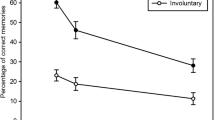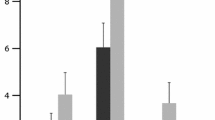Abstract
Involuntary memories are memories of past events that come to mind with no preceding attempts of retrieval. They typically arise in response to situational cues, but little is known as to how such cues modulate involuntary memories. Here, we examined how the sensory modality of the cues affects involuntary memory frequency and content. Participants watched first-person perspective films and were later presented with visuospatial and/or auditory cues from the films. We then assessed their experience of involuntary memories for other moments from the films. Across Experiments 1 and 2, visuospatial cues resulted in a greater frequency of involuntary memories, and produced memories with a higher proportion of visual content. In Experiment 3, this effect was replicated using a more auditorily engaging film and occurred whether participants focused on the film’s auditory or visual components, but was more pronounced when there was a match between encoding fixation and the retrieval cue. These findings suggest that visuospatial cues may outshine auditory cues in terms of involuntary memory elicitation and content.



Similar content being viewed by others
References
Aydin, C. (2018). The differential contributions of visual imagery constructs on autobiographical thinking. Memory, 26, 189–200.
Baddeley, A. (2000). The episodic buffer: A new component of working memory? Trends in Cognitive Science, 4, 417–423.
Berntsen, D. (1996). Involuntary autobiographical memories. Applied Cognitive Psychology, 10, 435–454.
Berntsen, D. (2001). Involuntary memories of emotional events: Do memories of traumas and extremely happy events differ? Applied Cognitive Psychology, 15, S135–S158.
Berntsen, D. (2009). Involuntary autobiographical memories. An introduction to the unbidden past. New York, NY: Cambridge University Press.
Berntsen, D., & Rubin, D. C. (Eds.). (2012). Understanding Autobiographical Memory: Theories and Approaches. New York: Cambridge University Press.
Berntsen, D., & Hall, N. M. (2004). The episodic nature of involuntary autobiographical memories. Memory & Cognition, 32, 789–803.
Berntsen, D., Staugaard, S. R., & Sørensen, L. M. T. (2013). Why am I remembering this now? Predicting the occurrence of involuntary (spontaneous) episodic memories. Journal of Experimental Psychology: General, 142, 426–444.
Berntsen, D., Rubin, D. C., & Salgado, S. (2015). The frequency of involuntary autobiographical memories and future thoughts in relation to daydreaming, emotional distress, and age. Consciousness and Cognition, 36, 352–372.
Berntsen, D., Rasmussen, A. S., Miles, A. N., Nielsen, N. P., & Ramsgaard, S. B. (2017). Spontaneous or intentional? Involuntary versus voluntary episodic memories in older and younger adults. Psychology and Aging, 32, 192–201.
Buhrmester, M. D., Talaifar, S., & Gosling, S. D. (2018). An evaluation of Amazon’s mechanical turk, its rapid rise, and its effective use. Perspectives on Psychological Science, 13, 149–154.
Congleton, A. R., & Berntsen, D. (2019). Psychological Research Psychologische Forschung. https://doi.org/10.1007/s00426-019-01215-0.
Ehlers, A., & Steil, R. (1995). Maintenance of intrusive memories in posttraumatic stress disorder: A cognitive approach. Behavioural and Cognitive Psychotherapy, 23, 217–249.
Ehlers, A., Hackmann, A., Steil, R., Clohessy, S., Wenninger, K., & Winter, H. (2002). The nature of intrusive memories after trauma: The warning signal hypothesis. Behaviour Research and Therapy, 40, 1021–1028.
Ehlers, A., Hackmann, A., & Michael, T. (2004). Intrusive re-experiencing in post-traumatic stress disorder: Phenomenology, theory, and therapy. Memory, 12, 403–415.
Grysman, A. (2014). The roles of gender and temporal distance in the recall of dissonant self-related memories. Consciousness and Cognition, 29, 10–22.
Grysman, A., Prabhakar, J., Anglin, S. M., & Hudson, J. A. (2015). Self-enhancement and the life script in future thinking across the lifespan. Memory, 23, 774–785.
Holmes, E. A., Brewin, C. R., & Hennessy, R. G. (2004). Trauma films, information processing, and intrusive memory development. Journal of Experimental Psychology: General, 133, 3–22.
Horowitz, M. J. (1975). Intrusive and repetitive thought after experimental stress. Archives of General Psychiatry, 32, 1457–1463.
Horowitz, M. J. (1986). Stress response syndromes (2nd ed.). Northvale: Aronson.
Mace, J. H. (2004). Involuntary autobiographical memories are highly dependent on abstract cueing: The Proustian view is incorrect. Applied Cognitive Psychology, 18, 893–899.
Mace, J. H. (Ed.). (2007). Involuntary memory. Malden. MA: Blackwell.
Maillet, D., & Schacter, D. L. (2016). From mind wandering to involuntary retrieval: Age-related differences in spontaneous cognitive processes. Neuropsychologia, 80, 142–156.
Mason, W., & Suri, S. (2012). Conducting behavioral research on Amazon’s mechanical turk. Behavioral Research Methods, 44, 1–23.
Mazzoni, G., Vannucci, M., & Batool, I. (2014). Manipulating cues in involuntary autobiographical memory: Verbal cues are more effective than pictorial cues. Memory & Cognition, 42, 1076–1085.
McDaniel, M. A., Anderson, C. D., Einstein, G. O., & O’Halloran, C. M. (1989). Modulation of environmental reinstatement effects through encoding strategies. American Journal of Psychology, 102, 523–548.
Morris, C. D., Bransford, J. D., & Franks, J. J. (1977). Levels of processing versus transfer appropriate processing. Journal of Verbal Learning & Verbal Behavior, 16, 519–533.
Rasmussen, A. S., & Berntsen, D. (2011). The unpredictable past: Spontaneous autobiographical memories outnumber autobiographical memories retrieved strategically. Consciousness and Cognition, 20, 1842–1846.
Rubin, D. C., & Berntsen, D. (2009). The frequency of voluntary and involuntary autobiographical memories across the lifespan. Memory & Cognition, 37, 679–688.
Rubin, D. C., & Umanath, S. (2015). Event memory: A theory of memory for laboratory, autobiographical and fictional events. Psychological Review, 122, 1–23.
Schlagman, S., & Kvavilashvili, L. (2008). Involuntary autobiographical memories in and outside the laboratory: How different are they from voluntary autobiographical memories? Memory & Cognition, 36, 920–932.
Schlagman, S., Kvavilashvili, L., & Schulz, J. (2007). Effects of age on involuntary autobiographical memories. In J. H. Mace (Ed.), Involuntary memory (pp. 87–112). Malden: Blackwell.
Shipley, W. C. (1940). A self-administering scale for measuring intellectual impairment and deterioration. The Journal of Psychology, 9, 371–377.
Smith, S. M. (2013). Effects of environmental context on human memory. In T. J. Perfect & D. S. Lindsay (Eds.), Sage handbook of applied memory (pp. 162–182). London: Sage Publications.
Smith, S. M., & Handy, J. D. (2014). Effects of varied and constant environmental contexts on acquisition and retention. Journal of Experimental Psychology: Learning, Memory & Cognition, 40, 1582–1593.
Smith, S. M., & Manzano, I. (2010). Video context-dependent recall. Behavior Research Methods, 42, 292–301.
Smith, S. M., Handy, J. D., Hernandez, A., & Jacoby, L. L. (2018). Context specificity of automatic influences of memory. Journal of Experimental Psychology: Learning, Memory, & Cognition, 44, 1501–1513.
Tulving, E. (1984). Precis of elements of episodic memory. Behavioral and Brain Sciences, 7, 223–268.
Tulving, E., & Pearlstone, Z. (1966). Availability versus accessibility of information in memory for words. Journal of Verbal Learning and Verbal Behavior, 5, 381–391.
Watkins, O. C., & Watkins, M. J. (1975). Buildup of proactive inhibition as a cue-overload effect. Journal of Experimental Psychology: Human Learning and Memory, 1, 442–452.
Zachary, R. A. (1986). Shipley Institute of Living Scale: revised manual. Los Angeles: Western Psychological Services.
Acknowledgements
This research was supported by grants from the Danish National Research Foundation (DNRF89) and the Danish Council for Independent Research (DFF-6107-00050). Special thanks to Sinué Salgado and Daniel Munkholm Møller for helping to manage data collection via Amazon Mechanical Turk.
Author information
Authors and Affiliations
Corresponding author
Ethics declarations
Conflict of interest
The authors report no conflicts of interest.
Ethical approval
This study was approved by the local ethics committee of the Department of Psychology and Behavioural Sciences at Aarhus University, and, as such, is in accordance with the ethical standards laid down in the 1964 Declaration of Helsinki and its later amendments.
Informed consent
All participants gave their informed consent prior to their inclusion in the study.
Human and animal rights statement
The manuscript does not contain clinical studies or patient data.
Additional information
Publisher's Note
Springer Nature remains neutral with regard to jurisdictional claims in published maps and institutional affiliations.
Rights and permissions
About this article
Cite this article
Congleton, A.R., Nielsen, N.P. & Berntsen, D. Through the gateway of the senses: investigating the influence of sensory modality-specific retrieval cues on involuntary episodic memory. Psychological Research 85, 1292–1306 (2021). https://doi.org/10.1007/s00426-020-01304-5
Received:
Accepted:
Published:
Issue Date:
DOI: https://doi.org/10.1007/s00426-020-01304-5




